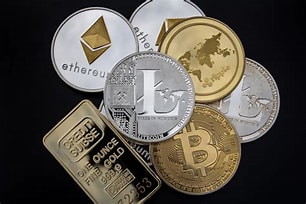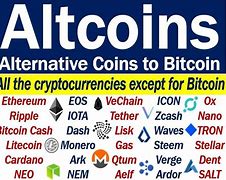The Rise of Altcoins
Introduction
In the ever-evolving world of cryptocurrency, Bitcoin often steals the spotlight as the first and most recognized digital currency. However, lurking in the shadows is a vibrant ecosystem of altcoins—alternative cryptocurrencies that have emerged to challenge Bitcoin’s dominance. This article explores the rise of altcoins, their unique characteristics, and how they contribute to a diverse and dynamic crypto landscape. So, what exactly are altcoins, and why should you care about them? Let’s dive in!
What Are Altcoins?
Defining Altcoins
The term altcoin is a blend of “alternative” and “coin,” referring to any cryptocurrency other than Bitcoin. With thousands of altcoins available today, each one serves different purposes and offers unique features. From Ethereum’s smart contracts to Ripple’s focus on cross-border payments, altcoins expand the possibilities of what cryptocurrencies can achieve.

Why Do Altcoins Exist?
Altcoins were created to address perceived limitations in Bitcoin or to explore new technological innovations. They often aim to improve transaction speeds, enhance privacy, or introduce new functionalities that Bitcoin doesn’t offer. This diversity fuels competition and innovation within the cryptocurrency space.
The Evolution of Altcoins
The Early Days: From Bitcoin to Altcoins
Bitcoin was launched in 2009 by the enigmatic Satoshi Nakamoto, and it quickly became the benchmark for digital currencies. However, as more developers recognized the potential of blockchain technology, they began creating alternative coins. The first significant altcoin was Litecoin, introduced in 2011 as a “lighter” version of Bitcoin with faster transaction times.
A Growing Market
Since those early days, the number of altcoins has exploded. As of now, there are over 20,000 altcoins in existence—each vying for attention and market share. This rapid growth reflects a burgeoning interest in cryptocurrencies beyond Bitcoin.
Types of Altcoins
Payment Tokens
Many altcoins serve as payment tokens, similar to Bitcoin but with specific enhancements. For example:
- Litecoin (LTC): Known for faster transaction times.
- Bitcoin Cash (BCH): Created to increase transaction capacity.
Smart Contract Platforms
Some altcoins focus on enabling smart contracts—self-executing contracts with terms directly written into code:
- Ethereum (ETH): The pioneer in smart contracts and decentralized applications (dApps).
- Cardano (ADA): Aims to provide a more secure and scalable platform for dApps.
Privacy Coins
Privacy-focused altcoins prioritize user anonymity:
- Monero (XMR): Offers enhanced privacy features that obscure sender and receiver identities.
- Zcash (ZEC): Provides optional anonymity for transactions.
Stablecoins
Stablecoins are pegged to traditional assets like fiat currencies to minimize volatility:
- Tether (USDT): Pegged to the US dollar.
- USD Coin (USDC): Another dollar-pegged stablecoin that emphasizes transparency.

Advantages of Altcoins
Innovation and Experimentation
One of the most exciting aspects of altcoins is their potential for innovation. Developers can experiment with new ideas, consensus mechanisms, and governance models without being bound by Bitcoin’s original framework. This creativity leads to diverse use cases that can benefit various industries.
Investment Opportunities
For investors, altcoins present opportunities for substantial returns. While they carry higher risks due to volatility, many altcoins have shown impressive growth rates. For instance, Ethereum saw its value skyrocket from under $10 in early 2016 to over $4,000 at its peak in 2021.
Lower Barriers to Entry
Many altcoins have lower price points than Bitcoin, making them more accessible for new investors. This affordability allows individuals to diversify their portfolios without committing large sums of money upfront.
Challenges Faced by Altcoins
Volatility and Risk
While the potential for high returns exists, investing in altcoins comes with significant risks. Many altcoins experience extreme price fluctuations influenced by market sentiment or technological developments. Investors must be prepared for this volatility.
Regulatory Scrutiny
As cryptocurrencies gain mainstream attention, regulatory bodies worldwide are scrutinizing them more closely. Some altcoins may face challenges regarding compliance with local laws or regulations, which could impact their viability.
Market Saturation
With thousands of altcoins available, distinguishing between promising projects and those likely to fail can be daunting. Investors must conduct thorough research before committing funds.
The Role of Altcoins in the Crypto Ecosystem
Complementing Bitcoin
While Bitcoin remains the dominant player in the cryptocurrency market, altcoins complement its ecosystem by offering additional functionalities and use cases. They help drive innovation and expand the overall appeal of cryptocurrencies.
Driving Adoption
Altcoins often target specific sectors or industries that can benefit from blockchain technology. By addressing niche markets—such as supply chain management or decentralized finance (DeFi)—altcoins contribute to broader acceptance of digital currencies.
Notable Altcoin Success Stories
Ethereum: The Smart Contract Pioneer
Ethereum revolutionized the crypto landscape by introducing smart contracts and dApps. Its robust ecosystem has attracted countless developers and projects, making it one of the most successful altcoins to date.
Binance Coin (BNB): From Exchange Token to Ecosystem Powerhouse
Originally created as a utility token for trading fee discounts on Binance exchange, BNB has evolved into a versatile asset used within the Binance Smart Chain ecosystem for various applications—from DeFi projects to NFT marketplaces.

The Future of Altcoins
Technological Advancements
As blockchain technology continues to evolve, we can expect further innovations within the altcoin space. Projects focusing on scalability solutions like Layer 2 technologies will likely gain traction as they enhance transaction speeds while reducing costs.
Integration with Traditional Finance
The lines between traditional finance and cryptocurrency are blurring. As more financial institutions explore blockchain solutions and integrate cryptocurrencies into their services, we could see increased legitimacy for both Bitcoin and altcoins alike.
Read This: The Evolution of Fashion Trends: A Look Back at the Last Decade
Conclusion
The rise of altcoins represents a dynamic shift in the cryptocurrency landscape—a shift that fosters innovation while challenging established norms set by Bitcoin. With diverse use cases ranging from smart contracts to privacy enhancements, altcoins play a crucial role in shaping the future of digital currencies. As you navigate this exciting world, remember that while opportunities abound, so do risks; staying informed is key to making wise investment decisions in this vibrant ecosystem.
FAQs
1. What are altcoins?
Altcoins are any cryptocurrencies other than Bitcoin that offer unique features or improvements over traditional digital currencies.
2. Why were altcoins created?
Altcoins were developed to address perceived limitations in Bitcoin or explore new technological innovations within blockchain technology.
3. What types of altcoins exist?
There are several types of altcoins including payment tokens (like Litecoin), smart contract platforms (like Ethereum), privacy coins (like Monero), and stablecoins (like Tether).
4. Are altcoins a good investment?
While some investors have seen significant returns from altcoin investments, they also carry higher risks due to volatility; thorough research is essential before investing.
5. How do altcoins complement Bitcoin?
Altcoins complement Bitcoin by offering additional functionalities and use cases that enhance the overall appeal of cryptocurrencies while driving innovation within the ecosystem.
Meta Description
Explore the rise of altcoins in the cryptocurrency ecosystem! Discover their unique features, advantages, challenges, and how they complement Bitcoin’s dominance!


